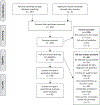Norovirus in Latin America: Systematic Review and Meta-analysis
- PMID: 27755462
- PMCID: PMC8006535
- DOI: 10.1097/INF.0000000000001369
Norovirus in Latin America: Systematic Review and Meta-analysis
Abstract
Background: Noroviruses are increasingly recognized as a major cause of sporadic and epidemic acute gastroenteritis (AGE). Although there have been multiple studies published on norovirus epidemiology in Latin America, no comprehensive assessment of the role of norovirus has been conducted in the region. We aim to estimate the role of norovirus in the Latin American region through a systematic review and meta-analysis of the existing literature.
Methods: We carried out a literature search in MEDLINE, SciELO and LILACS. We included papers that provided information on the prevalence or incidence of norovirus (including seroprevalence studies and outbreaks), with a recruitment and/or follow-up period of at least 12 months and where the diagnosis of norovirus was confirmed by reverse transcription polymerase chain reaction. The data were pooled for meta-analysis to estimate the prevalence of norovirus AGE and norovirus asymptomatic infection with 95% confidence intervals (CIs).
Results: Thirty-eight studies were included in the review. Overall, the prevalence of norovirus among AGE cases was 15% (95% CI: 13-18). By location, it was 15% in the community (95% CI: 11%-21%), 14% in outpatient settings (95% CI: 10%-19%) and 16% in hospital locations (95% CI: 12%-21%). The prevalence of norovirus among asymptomatic subjects was 8% (95% CI: 4-13). Norovirus GII.4 strains were associated with 37%-100% of norovirus AGE cases, but only 7% of norovirus asymptomatic detections.
Conclusions: Noroviruses are associated with almost 1 out of every 6 hospitalizations because of acute diarrhea in children younger than 5 years of age in Latin America.
Figures




Similar articles
-
Pooled prevalence and genetic diversity of norovirus in Africa: a systematic review and meta-analysis.Virol J. 2022 Jun 28;19(1):115. doi: 10.1186/s12985-022-01835-w. Virol J. 2022. PMID: 35765033 Free PMC article.
-
A systematic review and meta-analysis of the prevalence of norovirus in cases of gastroenteritis in developing countries.Medicine (Baltimore). 2017 Oct;96(40):e8139. doi: 10.1097/MD.0000000000008139. Medicine (Baltimore). 2017. PMID: 28984764 Free PMC article.
-
Global prevalence of norovirus in cases of gastroenteritis: a systematic review and meta-analysis.Lancet Infect Dis. 2014 Aug;14(8):725-730. doi: 10.1016/S1473-3099(14)70767-4. Epub 2014 Jun 26. Lancet Infect Dis. 2014. PMID: 24981041 Free PMC article.
-
Molecular epidemiology of noroviruses associated with acute sporadic gastroenteritis in children: global distribution of genogroups, genotypes and GII.4 variants.J Clin Virol. 2013 Mar;56(3):185-93. doi: 10.1016/j.jcv.2012.11.011. Epub 2012 Dec 5. J Clin Virol. 2013. PMID: 23218993
-
Signs and symptoms to determine if a patient presenting in primary care or hospital outpatient settings has COVID-19.Cochrane Database Syst Rev. 2022 May 20;5(5):CD013665. doi: 10.1002/14651858.CD013665.pub3. Cochrane Database Syst Rev. 2022. PMID: 35593186 Free PMC article.
Cited by
-
High Prevalence and Genetic Diversity of Human Norovirus Among Children Under 5 Years Old with Acute Gastroenteritis at the Dr. Leonardo Guzmán Regional Hospital, Antofagasta, Chile, 2019.Viruses. 2025 May 30;17(6):794. doi: 10.3390/v17060794. Viruses. 2025. PMID: 40573385 Free PMC article.
-
Rotavirus vaccines in Africa and Norovirus genetic diversity in children aged 0 to 5 years old: a systematic review and meta-analysis : Rotavirus vaccines in Africa and Norovirus genetic diversity.BMC Infect Dis. 2024 May 31;24(1):547. doi: 10.1186/s12879-024-09434-6. BMC Infect Dis. 2024. PMID: 38822241 Free PMC article.
-
Incidence of Norovirus-Associated Acute Gastroenteritis across Age Groups in a Peruvian Andean Community.Am J Trop Med Hyg. 2025 Jan 7;112(4):921-927. doi: 10.4269/ajtmh.24-0331. Print 2025 Apr 2. Am J Trop Med Hyg. 2025. PMID: 39773432 Free PMC article.
-
A Rapid Epidemiological Tool to Measure the Burden of Norovirus Infection and Disease in Resource-Limited Settings.Open Forum Infect Dis. 2017 Mar 17;4(2):ofx049. doi: 10.1093/ofid/ofx049. eCollection 2017 Spring. Open Forum Infect Dis. 2017. PMID: 28730158 Free PMC article.
-
Human enteroviruses associated with and without diarrhea in Thailand between 2010 and 2016.PLoS One. 2017 Jul 27;12(7):e0182078. doi: 10.1371/journal.pone.0182078. eCollection 2017. PLoS One. 2017. PMID: 28750058 Free PMC article.
References
-
- Wiegering V, Kaiser J, Tappe D, et al. Gastroenteritis in childhood: a retrospective study of 650 hospitalized pediatric patients. Int J Infect Dis. 2011;15:e401–e407. - PubMed
Publication types
MeSH terms
Grants and funding
LinkOut - more resources
Full Text Sources
Other Literature Sources
Medical

